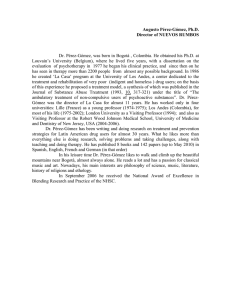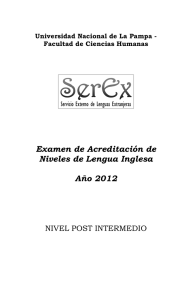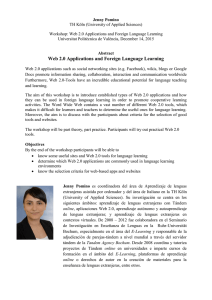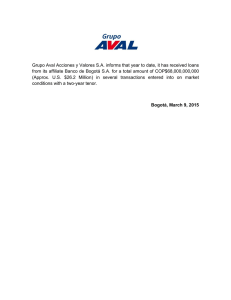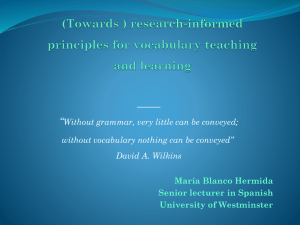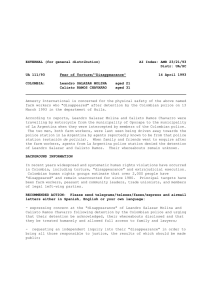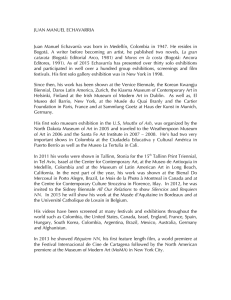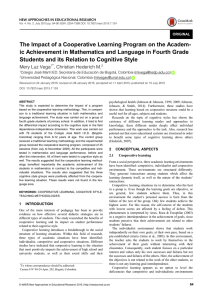Using Cooperative Learning to Foster the
Anuncio
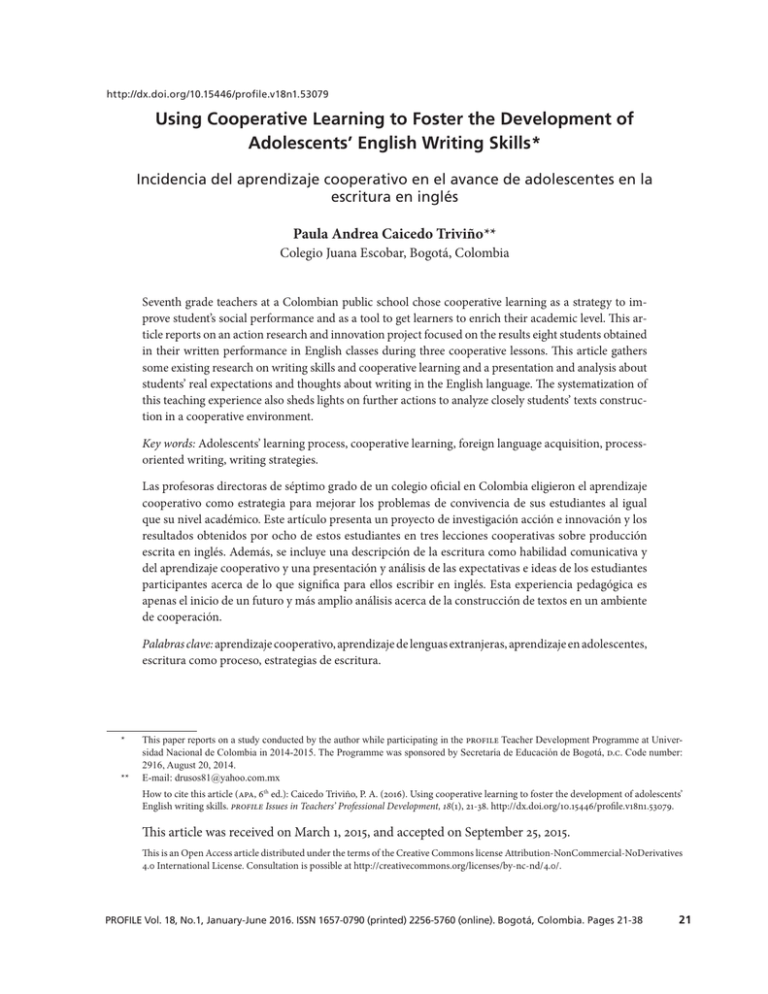
http://dx.doi.org/10.15446/profile.v18n1.53079 Using Cooperative Learning to Foster the Development of Adolescents’ English Writing Skills* 1 Incidencia del aprendizaje cooperativo en el avance de adolescentes en la escritura en inglés Paula Andrea Caicedo Triviño ** 2 Colegio Juana Escobar, Bogotá, Colombia Seventh grade teachers at a Colombian public school chose cooperative learning as a strategy to improve student’s social performance and as a tool to get learners to enrich their academic level. This article reports on an action research and innovation project focused on the results eight students obtained in their written performance in English classes during three cooperative lessons. This article gathers some existing research on writing skills and cooperative learning and a presentation and analysis about students’ real expectations and thoughts about writing in the English language. The systematization of this teaching experience also sheds lights on further actions to analyze closely students’ texts construction in a cooperative environment. Key words: Adolescents’ learning process, cooperative learning, foreign language acquisition, processoriented writing, writing strategies. Las profesoras directoras de séptimo grado de un colegio oficial en Colombia eligieron el aprendizaje cooperativo como estrategia para mejorar los problemas de convivencia de sus estudiantes al igual que su nivel académico. Este artículo presenta un proyecto de investigación acción e innovación y los resultados obtenidos por ocho de estos estudiantes en tres lecciones cooperativas sobre producción escrita en inglés. Además, se incluye una descripción de la escritura como habilidad comunicativa y del aprendizaje cooperativo y una presentación y análisis de las expectativas e ideas de los estudiantes participantes acerca de lo que significa para ellos escribir en inglés. Esta experiencia pedagógica es apenas el inicio de un futuro y más amplio análisis acerca de la construcción de textos en un ambiente de cooperación. Palabras clave: aprendizaje cooperativo, aprendizaje de lenguas extranjeras, aprendizaje en adolescentes, escritura como proceso, estrategias de escritura. * ** This paper reports on a study conducted by the author while participating in the PROFILE Teacher Development Programme at Universidad Nacional de Colombia in 2014-2015. The Programme was sponsored by Secretaría de Educación de Bogotá, D.C. Code number: 2916, August 20, 2014. E-mail: [email protected] How to cite this article (APA, 6th ed.): Caicedo Triviño, P. A. (2016). Using cooperative learning to foster the development of adolescents’ English writing skills. PROFILE Issues in Teachers’ Professional Development, 18(1), 21-38. http://dx.doi.org/10.15446/profile.v18n1.53079. This article was received on March 1, 2015, and accepted on September 25, 2015. This is an Open Access article distributed under the terms of the Creative Commons license Attribution-NonCommercial-NoDerivatives 4.0 International License. Consultation is possible at http://creativecommons.org/licenses/by-nc-nd/4.0/. PROFILE Vol. 18, No.1, January-June 2016. ISSN 1657-0790 (printed) 2256-5760 (online). Bogotá, Colombia. Pages 21-38 21 Caicedo Triviño Introduction Juana Escobar School is a public institution in Bogotá, Colombia, where students are continuously questioned about solving social problems with the strategy of promoting their autonomy and, at the same time, reinforcing their capability to see their partners as a support when it is needed to think about innovative ideas. The school community is distinguished by its heterogeneity which is reflected in the various problems students have in academic, discipline, and health aspects. Seventh graders at the Juana Escobar School have made evident the problems they have with academic and social performance in different classes; their study habits, their examinations results, and their behavior during the classes are clear examples of this situation. These are the reasons why their assigned teachers decided to adopt cooperative learning (CL) as a strategy to reduce the negative influence these aspects have had on their classes, since cooperative lessons permit strengthening several features such as autonomy, leadership, partners’ interaction, verbal and written communication, among many features (Arias, Cárdenas, & Estupiñán, 2005; Johnson, Johnson, & Holubec, 1999). The abovementioned cooperative characteristics were integrated into English classes to help these seventh graders acquire a major consciousness of their learning process. This is because they have evidenced some serious difficulties in basic aspects of English as a foreign language (EFL) such as vocabulary acquisition and sentences construction. However, it was necessary to emphasize only one skill to make the project more narrow and precise. Having this and the English classes’ characteristics in mind, it was considered as essential that these youngsters learnt how to write in a progressive but effective way. The writing learning process is a common teachers’ concern (Almazroui, 2008). Many EFL teachers have difficulties with students’ spelling of some words, the 22 copying of word by word from some texts, sentences arrangement, and the coherence of texts, just to name some. When learning to write, we usually tend to reproduce in written forms what we express orally and forget the importance contained in the edition of our texts, even if it is only a sentence. These complications become more momentous when what we want to say is supposed to be written in a foreign language; each student makes his or her own mistakes and it starts to be a challenge to the teacher to correct them and to make each learner overcome them. By writing cooperatively, these difficulties could be reduced; if each student among the group has a role to play (Johnson et al., 1999) and through his or her contributions the group reaches the proposed goal, each student would move forward in his or her learning process thanks to cooperative skills. Consequently, the project objective was to analyze the role of cooperative skills/work in the improvement of students’ writing skills and to be more specific about the results obtained in each planned activity; the research question was: What can be observed in students’ writings when they are engaged in cooperative learning? Because this article is intended to be a starting point in light of students’ perceptions about writing in English, cooperative work and roles within a group when cooperating play a very important role in what learners do during the lessons, which may differ from what the teacher expects. Literature Review Writing Skills Foreign languages (FL) teachers may have certain difficulties teaching the four language skills (listening, speaking, reading, and writing) whether using several strategies or explaining them as separated aspects of the language and these problems become more evident when they want their students to make a significant Universidad Nacional de Colombia, Facultad de Ciencias Humanas, Departamento de Lenguas Extranjeras Using Cooperative Learning to Foster the Development of Adolescents’ English Writing Skills improvement in their communication performance (Scott, 1995). Though there is no magic formula to acquire a certain skill suddenly, practice and the appropriate feedback from those who are “experts” can be a good starting point to develop a higher level in that skill. Let us see then what specifically occurs with writing skills. Some time ago, literacy, as a right to everyone, was not really an important matter; it was related to the upper classes or some privileged groups which had the opportunity to be in contact with this communicative form (Rivers, 1972). Currently, it has become a necessity to be literate not only to know how to communicate with the closest people around us, but also to know how to do it within an academic or professional context (Hyland, 2009). To be more specific, writing—which is a “young” activity in relation to the evolution of the human being—has taken place in several fields in academic and personal life; such as feelings expression, academic purposes, social networks, or personal growth (Graham & Perin, 2007). However, it is yet a skill which needs to be taught in order to be properly used (Rivers, 1972) and there is no better place for this than school. But then, what is it that we call writing? What do we need in order to structure a well-developed piece of writing? In regard to writing, we cannot forget the existence of several approaches that come from research and teaching practice (Yi, 2009) and have been used to support the validity of the effort to improve writing skills, not only in theory but also in practice through actions in the classrooms. Product oriented, process oriented, and reader oriented are the three main approaches which focus on the text, the writer, and the reader, respectively (Hyland, 2009). Because of the purpose of this article, the focus will be on the process approach. Peregoy and Boyle (2001) affirm that in the 60s, writing was a students’ creative activity in which teachers did not pay too much attention to the mistakes the learners made but to aspects such as the content, the freedom in choosing the topic, and the novelty in each written text. However, this practice sometimes made it impossible to read the students’ creations because of the numerous errors. Years later, this creative writing theory evolved into one that supported the idea of writing as a process; it placed emphasis on three perspectives which, according to Hyland (2009), have definitely supported this approach. The first is expressivist, in which “thinking precedes writing” (Hyland, 2009, p. 18). The second is cognitive, where writing is developed in five phases: prewriting, where the author conceives the ideas according to the potential reader; the drafting phase, where the writer puts the ideas on paper; the revising phase, where the author evaluates the text from the perspective of giving a determined message or if the text is appropriately written according to the audience; if so, the text needs editing and then it will be ready for publishing. Finally, the third perspective, social, has to do with the particular situation of the writing process; the specific author’s experience and context. According to Harmer (2007) the steps mentioned in the cognitive perspective cannot be described as a linear process since in the middle of writing we may need to re-plan or re-edit our ideas in order to make a better final draft. That is the reason why in the academic field students may need to be supported during all the writing process, perhaps not only by the teacher but also by their partners who may offer interesting ideas; furthermore, learners have also the opportunity to check unknown meanings in print or virtual dictionaries or in reference books. This writing process leads to a continuous reflection on the texts elaboration and on new learning strategies; it is what Arapoff (1967) has described as active thinking, a way in which the writer organizes the ideas having in mind the purpose, relevance, and scheme in the text, thus he or she cares about other things apart from spelling. It is relevant that the writer considers who PROFILE Vol. 18, No.1, January-June 2016. ISSN 1657-0790 (printed) 2256-5760 (online). Bogotá, Colombia. Pages 21-38 23 Caicedo Triviño the audience is, what the specific intention is when writing, and the register used to elaborate a more planned writing, which is clearly distinguished from the spoken discourse (Barnett, 1989; Harmer, 2007). The writer stops to think about how the different drafts are constructed and, progressively, this method becomes a skill that the learners start using daily. Process oriented writing makes text construction easier by reason of having just one task at a time (Peregoy & Boyle, 2001); it becomes a more friendly activity which is not felt as a “must” but as an enjoyable encounter with one’s own thoughts. In addition, process oriented writing develops into a much more interesting assignment for learners and teachers alike; it is not only a matter of having in mind an idea and capturing it in a text but also a process of building carefully the ideas to be transmitted and the feedback that will be given about that written work (Barnett, 1989). Teachers are much related to the way students assume their writing skills; it is a big responsibility to give an encouraging opinion about students’ expressions of their impressions and ideas; teachers should also be active thinkers before leading their learners into the writing process. Regarding writing in EFL, Figure 1 summarizes the perspectives some authors have about this topic. These perspectives can be divided into four categories: learning through the process, advantages of writing in FL, disadvantages of writing in FL, and feedback. According to the authors in Figure 1, when students are writing in a second language (L2) they become more confident thanks to the subdivision of steps during the process. They learn macro strategies while they are in this practice of prewriting, drafting, revising, editing, and publishing and micro strategies when they devote themselves to the text form; then, students are explicitly learning the process oriented writing (Barkaoui, 2007; Hinkel, 2015; Leki, Cumming, & Silva, 2008; Peregoy & Boyle, 2001). 24 The advantages mentioned by these researchers about process oriented writing are (a) the importance the students’ experience has when they are writing; that is, learners have a certain degree of freedom, they find the possibility of coming back to check what they have produced so far; (b) they have also the opportunity to start writing even if they do not know the FL perfectly, thanks to the knowledge they have of their mother tongue; (c) in several opportunities it proves easier for students to communicate in writing than by speaking, especially when they do not feel confident enough to stand in front of the class; and (d) little by little, students find their own writing style (Barkaoui, 2007; Hinkel, 2015; Leki et al., 2008; Peregoy & Boyle, 2001). Regarding the disadvantages of process oriented writing, first, the L2 learner could be among a multilevel group, even regarding L1 literacy knowledge, and this situation could affect his or her appropriate performance. Second, the spelling correction in academic texts is limited, which may affect the conventional language learning rules and the future performance these students will have with a more advanced writing. Regarding feedback, students are motivated by the fact that they receive comments not only from the teacher but also from their partners. This makes the process of writing to be less like a pressure for the student and more like a cooperative space to share knowledge within a friendly environment; much of it occurs as a class discussion rather than as an individual exercise. Cooperative Learning Cooperation is one of the paths humankind has followed along its evolution. It has permitted people to leave their primitive lives, become more human, learn from others, and also teach what has been necessary to move forward as a species (Ferreiro & Espino, 2000). Cooperation can be conceived as more than Universidad Nacional de Colombia, Facultad de Ciencias Humanas, Departamento de Lenguas Extranjeras Using Cooperative Learning to Foster the Development of Adolescents’ English Writing Skills Figure 1. Foreign Language Writing Characteristics Peregoy & Boyle (2001) Barkaoui (2007) 1. Students write from their experiences. 1. Acquisition of macro strategies (cognitive) and micro strategies (form and word searches). 2. Explicit teaching of the writing process. 3. Feedback gotten from partners is motivating and useful. 4. Teacher feedback must be balanced and not overwhelming neither careless in order to keep the student motivated. 5. Feedback could be done as a class discussion to realize how some errors affect writing and how to face them. 6. Provide students with opportunities to write even if they do not have the needed mastery for doing it. 2. Writing helps in revising and editing. 3. More freedom while writing since there will be more time to correct possible errors. 4. Every step during writing permits students to be more confident and have a more conscious learning. FL writing Leki, Cumming & Silva (2008) Hinkel (2015) 1. Due to the fact that L2 writers probably already have a certain literacy degree in L1, they can take that knowledge to help create the assigned texts in L2. 1. The writer finds his own style. 2. Learners are more willing to write than to speak in L2. 3. Students are more likely to improve their writing abilities with the support of partners and teacher. 4. L2 learners could be among a multilevel class even in L1 literacy. just sharing with others; it implies having in mind a particular goal and working with enough spirit and responsibility to complete it. This notion applies also to classrooms where in many opportunities we can observe that students have an objective but many of them do not know how to achieve it or do not even have the opportunity to try because of the competitive classroom environment. At this point, CL could be a solution to this lack of interest or empathy. CL is a concept which embraces many different aspects that can be easily associated with a harmonious learning environment; it is a strategy for the classroom that is used to increase motivation and retention, to help students develop a positive image of self and others, to provide a vehicle for critical thinking and problem solving, and to encourage collaborative social skills. (Calderón as cited in Christison, 1994, p. 140) This conception permits taking into account not only academic purposes in class but also goals related 2. The teaching of inflexible academic writing is limited. 3. ESL learners could be at a disadvantage since the process approach does not permit them to acquire the same vocabulary as first language (L1) learners and then academic writing would be a critical weakness when they are asked to produce more advanced level texts. to students’ self-esteem, new ways of thought, or a conscious and a critical point of view about the relation with others. If we describe CL main components, it can be easier to understand a little more about what it implies. According to Johnson, Johnson, and Holubec (1995) and Arias et al. (2005), CL is related to five main principles: Positive interdependence: Students have the responsibility of acquiring certain learning but they have also a commitment with the learning of the other participants of the group. Promotive interaction: During the discussions about the purposed topic in class, students are reinforcing their educational progress. Group processing: can be defined as the selfevaluation each group makes at the end of the lesson; they reflect upon their achievements and errors during the proposed activity. This allows the group to improve continuously in the positive interdependence acknowledgement. PROFILE Vol. 18, No.1, January-June 2016. ISSN 1657-0790 (printed) 2256-5760 (online). Bogotá, Colombia. Pages 21-38 25 Caicedo Triviño Cooperative skills: CL turns out to be a complex task since students are asked not only to learn academic skills but also interpersonal skills that must be taught by the teacher to help learners entirely handle them and become participants in real teamwork. Learners must then know each other, trust each other, communicate effectively, support each other, and solve possible conflicts constructively. The emphasis the teacher makes on each skill depends on the needs the groups have through the lessons. Individual accountability: Each learner is supposed to make a certain effort if the group has really achieving a goal in mind. For that reason each one is assigned a different role during the activities. Johnson et al. (1999) go further when they propose different types of roles the learners could assume according to the requirements they have to meet: Roles to help the group formation. Roles to help the group to work. Roles to help the students to express what they know and relate it to previous knowledge. Roles to help to encourage the learners’ thought and reasoning. The roles which are the most relevant for this research are the roles to help the group to work, those in which the group achieves its goals and keeps efficient relations. The ones chosen for the project were (Arias et al., 2005): Organizer: guides the group work, makes sure everyone in the group has the opportunity to participate. Recorder: takes notes of the group’s decisions, keeps the documents the group uses and produces. Obser ver : corrects possible mistakes in explanations and summaries, controls the group timing. Relationer: helps the group relate previous knowledge with the new knowledge and ensures that everyone in the group is following the presented topic. 26 Cooperative Writing This strategy differs from the one of writing alone since students have the chance to overcome as a team the possible obstacles they may face in an individual task; vocabulary recognition, brainstorming about any chosen topic, giving a certain structure to the text they want to elaborate, and error correction (Curry & Hewings, 2003). Elements like individual accountability and positive interdependence are continuously implemented when writing cooperatively (Duin, 1986); each student has his or her own responsibility about making a positive contribution to the group in order to reach the proposed goal and thus, discussing the means that could lead to that objective. Every time students are involved in a cooperative activity, they have the chance to reflect upon their performance during such activity; when sharing these ideas with their partners, they are taking advantage of promotive interaction and reinforcing the social skills required to make this approach more than a matter of group activity. The characteristics combination already mentioned creates the perfect environment for learning under agreed parameters, receiving useful and friendly feedback, sharing ideas respectfully, and permitting everyone in the class to improve personally and as a team. Method I carried out a study that followed the principles of action research and innovation in education (McNiff, 2013; Mills, 2007) which came from my interest in the difficulties some of my students had in putting their thoughts or ideas on paper when writing in English. The research mentioned was implemented having in mind the real situation of four seventh graders’ courses around social and academic aspects and included CL principles as an approach to help those students to be more conscious about their performance during some of the classes they attended. This proposal Universidad Nacional de Colombia, Facultad de Ciencias Humanas, Departamento de Lenguas Extranjeras Using Cooperative Learning to Foster the Development of Adolescents’ English Writing Skills on cooperative learning was made by the school counselor for the assigned teachers in that grade, and after reading and gathering some information about this approach, these teachers, me included, considered that each one of the four seventh grade courses had to be divided into nine groups of four learners, each student with a different cooperative role. The groups were arranged taking into account the students’ academic level, their learning style (Vallejos, n.d.), leadership characteristics in some of the students, and their social behavior during the classes. After the groups were organized, each assigned teacher started to plan the lessons following CL procedures (Arias et al., 2005) according to the needs of the courses and the corresponding topics included in the curriculum. Even though I worked with the four classes mentioned, I decided to focus on just two groups: Group 1 (students A, B, C, and D) and Group 2 (students E, F, G, and H) which were selected at random to make my research much more focused. Consistently, I decided to concentrate on the possible effects CL could have on these students’ writings due to the fact that our classes in the previous year emphasized written production and the results were not what I expected; students had problems constructing appropriate and coherent texts. Procedure As has already been mentioned, the intention of implementing CL in the English lessons was to revise the effect that approach could have on students’ progress while writing in an FL. Taking that aspect into account, it was necessary to plan three different lessons, carried out from September to November 2014, which involved written activities and distributed work for each group. The first two activities had comparative adjectives as a main topic and the third one was a free writing exercise. After each lesson, students and teacher evaluated their processes through cooperative skills management. The classes were planned according to Arias et al. (2005) “Global vision” of a cooperative lesson (p. 135) in which they propose five steps towards a well-developed lesson: (a) previous decisions and objectives approach, (b) lesson approach, (c) monitoring and intervention, (d) evaluation and processing, and (e) activities explanations to the students. The lessons were developed in six stages following the phases Burns (1999) presents as not necessarily separated or exclusive from each other: exploring, identifying, and planning; collecting data; analyzing and reflecting, hypothesizing and speculating; intervening and observing; reporting, writing, and presenting (see Figure 2). These phases though did not follow a strict order during the research development. Stage 1. Before the first lesson was developed, students answered individually a brief questionnaire (Appendix A) so that the teacher could learn their impressions corresponding to writing and both individual and group work. After this activity, I was able to get an overview of what the previous knowledge of the students was concerning the topics which would become our main subjects in the coming lessons. Stage 2. In Lesson 1, we did comparative sentences writing (Appendix B); students were asked to write a sentence in cooperative groups using an adjective I gave them on a piece of paper. In the group they assumed the correspondent cooperative role assigned by the teachers. The student performing the role of relationer checked the comparative rules to help the group remember the necessary information for writing this kind of sentences; the recorder took notes about their partners’ ideas; and the observer corrected possible mistakes in the sentence. When they finished, the organizer dictated the sentence to the teacher or passed it on a piece of paper for the sentence to be written on the whiteboard and later made the appropriate corrections. This lesson was developed in five rounds. PROFILE Vol. 18, No.1, January-June 2016. ISSN 1657-0790 (printed) 2256-5760 (online). Bogotá, Colombia. Pages 21-38 27 Caicedo Triviño Figure 2. Phases of the Study Stage 1 Questionnaire 1 Stage 2 Previous knowlege concerning writing and cooperative work. Lesson 1 Lesson 2 Comparative sentences The old me Stage 4 Stage 5 Stage 6 Questionnaire 2 Lesson 3 Questionnaire 3 Feelings and impressions concerning the work done. Free writing Final impressions Stage 3. In Lesson 2 “The Old Me,” students took some time to draw themselves at the age of 5; later they were asked to discuss with the group which personal and physical characteristics could be included in a written description of them at that age. Next, they had to write each one’s description taking into account that they had to compare the kids they used to be with their present adolescent selves. Stage 4. Questionnaire 2 just involved two headings for the student to complete: 1. I think the activity done the last lesson was… 2. While doing last lesson activity I felt… In this way, I could monitor the success of the activity in terms of pertinence for the students and see if they were as engaged with it as I considered they were. Stage 5. In the free writing activity students grouped to write a paragraph in any style and register according to their preferences. They could choose whether they wanted to write among the set groups 28 Stage 3 or if they wanted to write in pairs or individually (the implications of working individually while in a CL lesson will be discussed in the findings section). Stage 6. At the end of the lessons, students were asked (Questionnaire 3) about their impressions and feelings about their performance during the classes mentioned (Appendix C). Findings The data collected came from questionnaires, lesson plans, observation, and field notes that were analyzed following the principles suggested by Burns (1999) in which reflection is a continuous matter during the whole investigation process. When I began the study, I started separating different types of data in folders and had a sheet of paper in each one for note taking. In this way, it was easier to start scanning and comparing data to find general patterns in the samples related to the objective of the project. Universidad Nacional de Colombia, Facultad de Ciencias Humanas, Departamento de Lenguas Extranjeras Using Cooperative Learning to Foster the Development of Adolescents’ English Writing Skills The information was narrowed from those patterns, which took a lot of time since the questionnaires I was dealing with contained openended questions which made students’ answers more realistic and related to their feelings and thoughts. In comparing the data, I created charts to group the eight students’ answers and see more clearly the categories mentioned and repetitions in some of the students’ answers. From all this analysis two categories emerged: Cooperative Work Role in the English Classroom and Students’ Cooperative Process Oriented Writing. Cooperative Work Role in the English Classroom The analysis of this category led me to center on the five principles of CL: positive interdependence, promotive interaction, individual accountability, group processing, and cooperative skills. Although students had a general vision of cooperative work before the lessons started (Appendix A), Everyone gives an opinion to make the work be okay. (Student A, Recorder)1 The one who doesn’t know can be helped by the others, which is team work. (Student G, Observer) they had serious difficulties when understanding and implementing their roles within the group and assuming such role as a part of the entire cooperative process maybe because, in spite of the fact that in every one of the three lessons students had the same roles, they were in some way modified by the lesson contents and dynamics. For example, the recorders who were in charge of taking notes and keeping the group documents confused the moments when they were supposed to write their partners’ comments, engage in brainstorming, or create ideas for composing the required texts for each lesson. 1 The samples in this article have been translated from Spanish. The difficulties mentioned were made evident during all the classes when students constantly asked about what they were supposed to do as organizers, relationers, observers, or recorders. It was, of course, disappointing, since I devoted around 7 or 10 minutes at the beginning of these lessons to arrange the classroom, explain the roles assignment, the academic and cooperative skills objectives of the lesson, and the times for each step in it (Appendix B). However, all this information was a continuous question during the whole class. Besides this, I observed that the positive interdependence (Johnson et al., 1995) decreased progressively in the two groups. In Lesson 1, students were very interested in ensuring that the whole group was involved in the activity and the sentence construction process; in Lesson 2, only students B, D, and E performed the activity as it was proposed. Student A was continuously standing up and the other students just made their self drawings and did not write any comparative sentence. In Lesson 3, which I considered would be the most productive in terms of attitudes and performance to be analyzed, the results were the opposite. As students could make the decision of not working within the complete group but in pairs, some of the students in Group 1 even decided to work individually and when I asked about the reason, they argued they did not want to have to reach an agreement about the topic, so they preferred to work this way and avoid conflict. However, at the moment of checking the work done, only Student B was doing a paragraph about her routine. Group 2 decided to work together and asked many questions regarding grammar and appropriate vocabulary. These discussions and continuous questioning about the right path to achieve any goal (Durán & Vidal, 2004) are what confirm the previous conception students had about cooperation before the lessons began: PROFILE Vol. 18, No.1, January-June 2016. ISSN 1657-0790 (printed) 2256-5760 (online). Bogotá, Colombia. Pages 21-38 29 Caicedo Triviño The whole group is thinking, everybody can give an opinion and is more likely there will be right answers. (Student E) Regarding group processing, even when I considered that self-evaluation would be a difficulty in terms of the objectiveness students could have at the moment of evaluating cooperative skills management during the lessons, I have to say it was very productive. As I monitored the groups, I observed positive attitudes towards the effective achievement of the proposed goals given at the beginning of each lesson. Students told each other off for standing up and leaving the group, for making so much noise, for not performing their role within the group, and so on, and at the end of the lessons, when the moment came to make the groupprocessing chart (Figure 3) and evaluate everybody’s work, they did not forget any of these details. Students E and H clearly stood out because of the accomplishment in all of the skills which facilitated the academic purposes of the lesson. These cooperative skills were not purely academic but were more related to social performance of each group inside the whole class or as a whole constructing the best conditions to move forward in each step of the lesson. On the part of the learners, after making an approach to cooperative work, they considered it as a useful tool to improve their skills. Regarding cooperative skills roles during the lessons, they see the relevance of having a role in a group, if it is so that they want to achieve a certain goal. Nevertheless, in many opportunities there was a notorious decrease in the roles assumption as the activities became more formal; this contradicts what they said in the Questionnaires 1 and 3: I liked [my role] very much because I could listen to the others’ Figure 3. Lesson 2, Group 2 Processing-Chart 2 thoughts. (Student E, Relationer) [My role made sense] because we learnt to work more orderly. (Student D, Organizer) Some students believed they perform better if they work in a group; they think their ideas have more support if their partners act as a guarantor of the thoughts and impressions they have (Appendix A). This is a positive aspect if we consider only CL as a tool in class, but if we ask students to work individually in any moment this mistrust could become an obstacle for the learner to participate effectively in class. In Lesson 2, for example, the cooperative skills students evaluated were: 1. Stay in the group 2. Speak in a quiet voice 3. Express ideas and opinions 4. Promote partners’ participation 5. Help partners to remember 2 Figure 3 headings from left to right: Members (E, G, F, H) and skills (1 to 5). 30 Students’ Cooperative Process-Oriented Writing During the project development, it was possible to identify several aspects related to the students’ writing and cooperative skills. Learners recognized writing as a process since in the cooperative lessons they were always elaborating previous drafts to come up with the final text; every time they were asked to write they did it first in their mother tongue; moreover, they used to have an extra piece of paper apart from Universidad Nacional de Colombia, Facultad de Ciencias Humanas, Departamento de Lenguas Extranjeras Using Cooperative Learning to Foster the Development of Adolescents’ English Writing Skills their notebooks to arrange sentences from their ideas (Peregoy & Boyle, 2001). This implies they gave real importance to writing; it is something they wanted to do step by step in order to give the right message to their reader (Barkaoui, 2007). However, when teaching adolescents it can be hard to get them involved in the same manner in the activities the teacher proposes, and in this case, it was not the exception. From the eight students who contributed to this project, only three did the activities showing responsibility and real commitment during the entire process, which affected to some extent the “success” of the tasks done. During Lesson 1, it was interesting to see how every student in the two groups was committed to do the task of building sentences. They participated and worked on the coherence and syntax of each sentence, they seemed to be interested in writing accurately and they did so; after two rounds of comparative sentences, they started writing coherently (Leki et al., 2008). Lesson 2 “The Old Me,” was a little less productive since, as I explained before, only three students decided to work on the activity (Figure 4), and they did an amazing job since they easily completed the task working almost individually, though it was not the pedagogical objective. In Figure 4 it is evident Student D made an effort to write coherent sentences taking into account grammatical aspects. During the lesson, she was continuously asking if she was doing a good job, and in this manner took advantage of the editing and revising steps in process oriented writing, which permitted her to be more confident about the text she was creating and at the same time about her learning process (Peregoy & Boyle, 2001). Student D was interested in making her message clear to the reader and she wrote regardless of the fact she did not know all the vocabulary she wanted to use (Barkaoui, 2007). Figure 4. “The Old Me:” Sample From Student D Lesson 3, free writing, was an opportunity to identify some mistakes students made when using the dictionary and for the teacher to check closely the writing process of the students who decided to complete the activity. Student B, for example, started by writing in Spanish first to clarify her ideas and then she started to translate. She did not seem very sure about her vocabulary knowledge and after all, she did not want to receive help from her partners as she could only trust the dictionary and me when writing. Yesterday when more leave of school I went where my grandmother and placed to play football, baseball and secretly, with my cousin later more accompany to my grandmother to buy the market, later I went to the house, see TV to my put sleep. [sic] In relation to Group 2, they did cooperative work in this lesson and wrote about ghosts. The ghost are transparent and fly, also are white and bad, the ghost are small and big the like live in the darkness. my like that the ghost frighten to people. [sic] They were concerned about the accuracy of the text and asked questions about the syntax; however, the use of dictionary was reduced. They were confident (Peregoy & Boyle, 2001) and motivated by the fact that they obtained mostly feedback from the group (Barkaoui, 2007). Process oriented writing PROFILE Vol. 18, No.1, January-June 2016. ISSN 1657-0790 (printed) 2256-5760 (online). Bogotá, Colombia. Pages 21-38 31 Caicedo Triviño was a motivation for this exercise due to the support students had from each other in editing, the freedom at the moment of choosing a topic, and when they asked the teacher about any possible mistake they made. It will always be motivating to see students who make an effort to write and express their ideas or points of view in English even when they do not comprehend grammar rules completely. Conclusions After analyzing the role of cooperative work in the improvement of students’ writing skills, which was the project objective, I can conclude that CL and writing skills can be worked together to improve several academic and personal skills. Nevertheless, I consider that three lessons did not provide enough time and practice to achieve all the expected results. There are many aspects to consider in the implementation or improvement of this approach application if it is going to be used as a learning strategy. Surveys are a determinant starting point to know students’ real expectations and a tool to track the perceptions students have about the work developed in classes, not only in cooperative lessons but as a constant evaluation of the teaching processes. Before implementing cooperative lessons, students should have one or two informative lectures about the elements involved in such classes. This could have many advantages, firstly, for the teachers, who can receive from the students questions about the cooperative features which would permit improvements in the lesson plans and provide a wider knowledge of such features. Secondly, for the students, who could find it interesting working in teams if they consider the ideas of progress, help, and cooperation as instruments which, properly used, would take their strengths or weaknesses to a different level. Cooperative lessons work to improve social skills in the classroom; unfortunately, the sample groups could not work in agreement with the groups’ organization 32 the teachers proposed but I consider it was more a matter of time than of cooperative skills themselves. We were already ending the school year and did not have time to use other strategies like rearranging the groups according to the students’ empathy. Having in mind the research question, I ask what could be observed in students’ writings when they were engaged in cooperative learning, disregarding the difficulties involved in writing in L2. Processoriented writing is an excellent starting point to revise students’ interests in writing, ensure their vocabulary improvement, their style correction, and how confident they are in the abilities they have. Even though the project lasted a few weeks, there was enough time for the students to notice the importance of a step by step edition when writing coherently; this, I consider, will be useful when they face text construction in future lessons, since they will feel more independent about resorting to their previous knowledge. During the project, learners started to be more conscious about the importance of expressing their ideas on paper to make others understand the message and although on many occasions they preferred to use Spanish in some daily expressions, I, as their teacher, tried to avoid that situation which was an obstacle at the moment of writing. It was necessary learners noticed that; those who devoted attention to the proposed activities evidenced a significant improvement in their vocabulary and use of certain grammatical structures thanks to the editing process of their writings. These conclusions lead me to determine that since process-oriented writing approach only gives one a perspective of what writing means, it cannot be the only source teachers and students use when they are trying to expand this skill. Other approaches are needed to create more formal texts and to present other perspectives about creation in writing, which address the interests and needs of each student during the academic year. Universidad Nacional de Colombia, Facultad de Ciencias Humanas, Departamento de Lenguas Extranjeras Using Cooperative Learning to Foster the Development of Adolescents’ English Writing Skills Further Implications CL is a strategy which is worth it to continue working on future lessons; this project has only been an approach to it and it would be necessary to work much more in it so that teacher and students completely master what CL involves. There are several details in this approach that need to be considered in the improvement of lesson planning and learners’ appropriation of their roles during the classes. Writing, though difficult, is a valuable source of prospects to improve L2 acquisition in schools. Sometimes it is impossible to track every student’s progress in this skill but it is really worth it to take the time for it and to give meaningful feedback to learners. Many times, due to curriculum requirements, teachers have to implement many strategies in many lessons, which do not always provide the results we expect. This is why it would be more useful to concentrate on just one activity so that we can focus more rigorously on students’ results and progress. Burns, A. (1999). Collaborative action research for English language teachers. London, UK: Cambridge University Press. Christison, M. A. (1994). Cooperative learning in the EFL classroom. In T. Kral (Ed.), Teacher development: Making the right moves. Selected articles from the English Teaching Forum 1989-1993 (pp. 139-147). Washington D.C.: English Language Programs Division. Curry, M. J., & Hewings, A. (2003). Approaches to teaching writing. In C. Coffin, M. J. Curry, S. Goodman, A. Hewings, T. M. Lillis, & J. Swann (Eds.), Teaching academic writing (pp. 19-44). London, UK: Routledge. Duin, A. H. (1986). Implementing cooperative learning groups in the writing curriculum. Journal of Teaching Writing, 5(2), 315-324. Durán, D. & Vidal, V. (2004). Tutoría entre iguales: de la teoría a la práctica. Un método de aprendizaje cooperativo para la diversidad en secundaria [Tutorials between equals: From theory to practice. A cooperative learning method for diversity in high school]. Barcelona, ES: Graó. Ferreiro, R., & Espino, M. (2000). El abc del aprendizaje References Almazroui, K. (2008). Strategies used by sixth grade students of the United Arab Emirates when standard cooperativo: trabajo en equipo para enseñar y aprender [Cooperative learning rudiments: Team work to teach and learn]. Mexico, D.F.: Editorial Trillas. spelling is unknown. In C. Coombe, A. Jendli, & P. Graham, S., & Perin, D. (2007). A meta-analysis of writing Devidson (Eds.), Teaching writing skills in EFL: Theory, instruction for adolescent students. Journal of Educa- research and pedagogy (pp. 139-173). Dubai, AE: TESOL tional Psychology, 99(3), 445-476. Arabia Publications. Arapoff, N. (1967). Writing: A thinking process. TESOL Quarterly, 1(2), 33-39. Arias, J., Cárdenas, C., & Estupiñán, F. (2005). Aprendizaje cooperativo [Cooperative learning]. Bogotá, CO: Universidad Pedagógica Nacional. Harmer, J. (2007). How to teach writing. London, UK: Longman. Hinkel, E. (2015). Effective curriculum for teaching L2 writing: Principles and techniques. New York, NY: Routledge. Hyland, K. (2009). Teaching and researching writing. London, UK: Pearson. Barkaoui, K. (2007). Teaching writing to second language Johnson, D. W., Johnson, R. T., & Holubec, E. J. (1995). Los learners: Insights from theory and research. TESL nuevos círculos de aprendizaje: cooperación en el salón Reporter, 40(1), 35-48. de clases y en la escuela [The new circles of learning: Barnett, M. A. (1989). Writing as a process. The French Review, 63(1), 31-44. Cooperation in the classroom and school]. Alexandria, VA: ASCD. PROFILE Vol. 18, No.1, January-June 2016. ISSN 1657-0790 (printed) 2256-5760 (online). Bogotá, Colombia. Pages 21-38 33 Caicedo Triviño Johnson, D. W., Johnson, R. T., & Holubec, E. J. (1999). El aprendizaje cooperativo en el aula [Cooperative learning in the classroom]. Buenos Aires, AR: Paidós. Leki, I., Cumming, A., & Silva, T. (2008). A synthesis of research on second language writing in English. New York, NY: Routledge. McNiff, J. (2013). Action research: Principles and practice. New York, NY: Routledge. Mills, G. E. (2007). Action research: A guide for the teacher researcher. Columbus, NJ: Pearson. Peregoy, S. F., & Boyle, O. F. (2001). Reading, writing and learning in ESL: A resource book for teaching K-12 English Rivers, W. M. (1972). Teaching foreign-language skills. Chicago, IL: University of Chicago Press. Scott, V. M. (1995). Rethinking foreign language writing. Boston, MA: Heinle Publishers. Vallejos, S. P. (n.d.). Herramientas didácticas y docentes: el test de David Kolb [Didactic and teaching tools: David Kolb’s test]. Retrieved from http://www.rmm.cl/index_ sub2.php?id_contenido=10497&id_seccion=2816&id_ portal=432. Yi, J. (2009). Defining writing ability for classroom writing assessment in high schools. Pan-Pacific Association of Applied Linguistics, 13(1), 53-69. learners. New York, NY: Longman. About the Author Paula Andrea Caicedo Triviño holds a Bachelor Degree in Humanities from Universidad Pedagógica Nacional (Colombia) and a Diploma in translation English-Spanish from Universidad del Rosario (Colombia). Currently, she is a full time English teacher at Colegio Juana Escobar, Bogotá. 34 Universidad Nacional de Colombia, Facultad de Ciencias Humanas, Departamento de Lenguas Extranjeras Using Cooperative Learning to Foster the Development of Adolescents’ English Writing Skills Appendix A: Questionnaire 1 Complete the headings writing your opinion about each one of the mentioned aspects: 1. I think writing is… ________________________________________________________________________________ ________________________________________________________________________________ ________________________________________________________________________________ 2. Writing in Spanish is… ________________________________________________________________________________ ________________________________________________________________________________ ________________________________________________________________________________ 3. Writing in English is… ________________________________________________________________________________ ________________________________________________________________________________ ________________________________________________________________________________ 4.The advantages of working individually are… ________________________________________________________________________________ ________________________________________________________________________________ ________________________________________________________________________________ 5. The disadvantages of working individually are… ________________________________________________________________________________ ________________________________________________________________________________ ________________________________________________________________________________ 6.The advantages of working in groups are… ________________________________________________________________________________ ________________________________________________________________________________ ________________________________________________________________________________ 7. The disadvantages of working in groups are… ________________________________________________________________________________ ________________________________________________________________________________ ________________________________________________________________________________ PROFILE Vol. 18, No.1, January-June 2016. ISSN 1657-0790 (printed) 2256-5760 (online). Bogotá, Colombia. Pages 21-38 35 Caicedo Triviño Appendix B: Lesson Plan Sample Cooperative Lesson 1: Comparatives Content Area: English Classes: 702-703-704 Previous decisions and objective posing Group Size: Four students Students’ assignment to each group: taking into account who the leaders of the class are and who needs to improve in academic and discipline aspects. Classroom Arrangement: U shaped. Materials: English-Spanish dictionaries, comparatives list previously elaborated in class. Roles assignment: Students write short sentences to tell the class about their appearance in the past comparing it with their actual appearance. Time: 15 minutes for the teacher to explain the activity, skills, and evaluation percentages. 15 minutes for SS to draw themselves when they were 5 years old. 15 minutes to provide students with vocabulary and useful expressions. 10 minutes for SS to brainstorm about physical or intellectual aspects they want to compare. 40 minutes for sentences writing. Five minutes to organize the classroom. Academic objective: strengthen SS skills in brainstorming, writing with a purpose, sharing their ideas, using previous concepts, and listening to others’ opinions. Cooperative skills objective: stay in the group, speak in a quiet voice, express ideas and opinions, and promote partners’ participation. Lesson planning Cooperative procedure description: Mutual questioning technique will be used. SS are asked to draw themselves on a piece of paper to reflect on their appearance when they were 5 years old. After that, SS brainstorm with their group on which topic could be relevant to make a comparison of their way of being when children and their current way; they can include physical or personality issues. Finally, SS write in sentences next to their drawings of those aspects. 36 Universidad Nacional de Colombia, Facultad de Ciencias Humanas, Departamento de Lenguas Extranjeras Using Cooperative Learning to Foster the Development of Adolescents’ English Writing Skills Positive interdependence: Resources: SS will be given just one dictionary. Roles: organizer (directs the brainstorm and encourages the group), recorder (verifies the group writings), observer (verifies the group is really working), and relationer (consults the comparatives rules). Reward: If the whole group finishes 5 minutes earlier than the given time, they get extra points. Success criteria: Cooperative skills are 50% and the written product 50% of the grade. Individual responsibility: following instructions and performing his/her role in the group to reach success. Groups’ cooperation: respect other groups’ activity development. Intervention The T will explain the role of each S, the cooperative skills, success criteria, time, and will solve questions during the lesson. Evaluation and processing Students and teachers evaluate their own performance during the lesson having in mind the skills and objectives set. Activities explanation to the students Learners are given the topic of the lesson, the objectives in it, the cooperative lessons they must take into account during the whole class as success criteria. In the same way, the teacher tells them about the time limit for each activity during the lesson and reminds them about the roles they are playing in this specific lesson. PROFILE Vol. 18, No.1, January-June 2016. ISSN 1657-0790 (printed) 2256-5760 (online). Bogotá, Colombia. Pages 21-38 37 Caicedo Triviño Appendix C: Questionnaire 3 Answer the following questions: 1. What is your role in the lessons? ________________________________________________________________________________ ________________________________________________________________________________ ________________________________________________________________________________ ________________________________________________________________________________ ________________________________________________________________________________ 2. How did you feel playing this role? ________________________________________________________________________________ ________________________________________________________________________________ ________________________________________________________________________________ ________________________________________________________________________________ ________________________________________________________________________________ 3. Did this role make sense in your group? ________________________________________________________________________________ ________________________________________________________________________________ ________________________________________________________________________________ ________________________________________________________________________________ ________________________________________________________________________________ 4. What would you do different in a future lesson? ________________________________________________________________________________ ________________________________________________________________________________ ________________________________________________________________________________ ________________________________________________________________________________ ________________________________________________________________________________ 5. Would you like to have a different role in the group? If so, which one? ________________________________________________________________________________ ________________________________________________________________________________ ________________________________________________________________________________ ________________________________________________________________________________ ________________________________________________________________________________ 38 Universidad Nacional de Colombia, Facultad de Ciencias Humanas, Departamento de Lenguas Extranjeras
